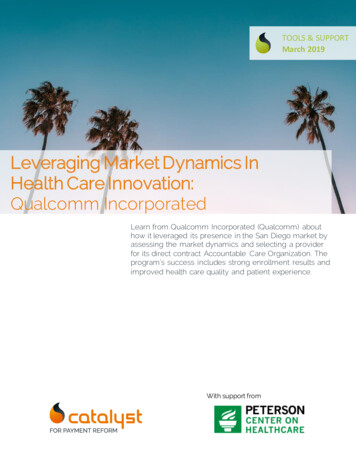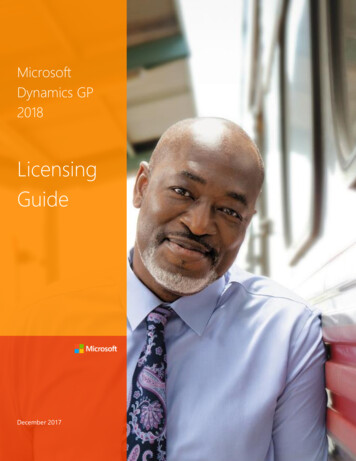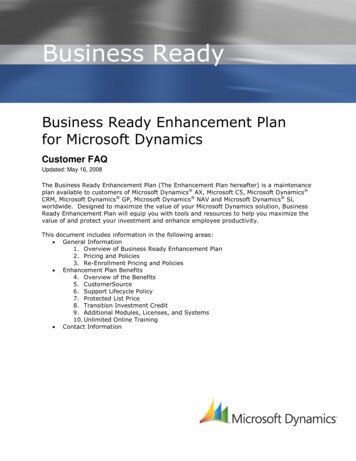
Transcription
TOOLS & SUPPORTMarch 2019Leveraging Market Dynamics InHealth Care Innovation:Qualcomm IncorporatedLearn from Qualcomm Incorporated (Qualcomm) abouthow it leveraged its presence in the San Diego market byassessing the market dynamics and selecting a providerfor its direct contract Accountable Care Organization. Theprogram’s success includes strong enrollment results andimproved health care quality and patient experience.With support from
Case StudyLeveraging Market Dynamicsin Health Care InnovationQualcomm Incorporated (Qualcomm) is a large telecommunications equipment andsemiconductor company, headquartered in San Diego, California. The company was founded in1985 and has almost 30,000 employees worldwide. Since 2016, Qualcomm has offered aQualified Deductible Health Plan that can be coupled with a Health Savings Account (HSA) asthe only health plan option for its US employees. With the exception of a charge to coverworking spouses declining their own employer’s coverage, Qualcomm employees pay nopremiums to participate in Qualcomm’s health plan.Qualcomm is one of the largest private employers in the San Diego metropolitan area. Based onthe growing footprints and capabilities of the large health care systems in the market and theincreasingly flexible models offered by the carriers, Qualcomm embarked on an effort to take afresh look at contracting for and delivering health care services for Qualcomm’s San Diegopopulation. In doing so, Qualcomm enlisted multiple partners, including Catalyst for PaymentReform (CPR), to assess the market and select a health system with which to partner, along witha carrier to support the arrangement.CPR’s main point of contact at Qualcomm was Teresa Wolownik, Senior Director of GlobalBenefits and Health Services. Throughout the process of conducting its market assessment, CPRalso spoke with many other health care leaders and stakeholders in the San Diego market.The Problem & BackgroundSeeking a better patient experienceQualcomm’s top objective was to develop a solution that would deliver a superior experiencefor patients. Too often were patients not adequately supported in the traditional health caredelivery model - from timely access to care, to coordinating care across multiple specialists, tobeing stuck at the center of medical coding errors that would impact them financially if notresolved. Additionally, Qualcomm looked to drive quality and health improvement by payingproviders for the value of the care they delivered, not just for the volume of services theyprovided. Not satisfied with the standard solutions available in the market, Teresa believed adirect, customized arrangement with one of San Diego’s large and innovative health systemsmight best meet Qualcomm’s objectives.For distribution contact info@catalyze .orgAvailable for download at www.catalyze.org2
Of all the innovations employers and other purchasers have implemented to get higher valuecare, an accountable care organization (ACO) approach seemed to align most closely withQualcomm’s goals. An ACO is a high-performance network of providers that shares financial andmedical responsibility for providing coordinated care to a patient population and eliminatingwaste in the system. As such, ACOs attempt to address the triple aim—improve patientexperience, improve population health, and reduce per capita cost. In addition, Teresa wanted amodel that leveraged the personal physician to help patients navigate the health care systemand resolve issues. Accordingly, Qualcomm initiated a process to assess the capabilities,readiness and interests of the local health systems and carriers to develop a customized, directcontract ACO featuring strong member service and support.The ProcessWhile Qualcomm had a vision to improve health care delivery for its San Diego employees, ittook an analytical approach to understanding the needs of its population and associated marketoptions to shape its strategy.1. Analysis of cost and quality variationIn 2014, Qualcomm commissioned a study of its own health claims data to understand thevariations in clinical care and payment in San Diego, as well as to identify shortcomings. Thestudy validated expectations that there was a wide range in pricing for routine services, alongwith variation across providers in the quality of care they delivered.2. CPR market readiness assessmentIn 2015, Qualcomm sought CPR’s help with assessing the dynamics of and opportunities in theSan Diego market. Over five years in five different markets, CPR had developed an investigativeprocess to shed light on local dynamics among providers, health insurance carriers andpurchasers, and which payment and delivery reforms are likely to succeed based on thosedynamics. In this case, Qualcomm had a potential solution in mind, but wanted CPR’s help tounderstand the capabilities of the key players in San Diego, including their willingness to partneron an innovative approach. CPR carried out a multi-step inquiry, which included the following: General Market Assessmento Market Research: CPR gathered structural and statistical data on San Diego, such asthe size of the population, the breakdown in sources of insurance coverage, and themarket share held by each of the major health care stakeholders.o Online Survey: CPR developed and fielded an online survey to the major healthsystems and carriers in San Diego to capture their views of the market—in terms ofmarket power, innovation, and their experience with, and appetite for health carereforms.For distribution contact info@catalyze .orgAvailable for download at www.catalyze.org3
o Summary of Findings: CPR analyzed the survey responses and, combined with thestructural data, shared a summary of the general health care market dynamics in SanDiego with Qualcomm’s health benefits team. The market research and survey resultsdemonstrated that San Diego has a highly evolved health care marketplace withmultiple, competing integrated delivery systems, putting it ahead of the country inpayment and delivery evolution. Many of the key players have been experimentingwith payment and delivery reform for several years and were ready to pilot newapproaches, suggesting that San Diego was well-suited to the customized solutionQualcomm was seeking. Stakeholder Request for Information: Based on the goals communicated by Qualcomm,CPR developed separate Requests for Information (RFIs) for health systems and for carriersto gather and compare in detail their experience with payment and delivery reforms, benefitand network offerings, focus on primary care and experience with ACOs, and innovations inmaternity care, among other capabilities. Recommendations: CPR analyzed each of thehealth system responses and each of the carrierresponses and developed a summary presentationto convey stakeholder capabilities to the Qualcommteam. Drawing on CPR’s detailed understanding ofpayment and delivery reform as well as the researchCPR conducted in San Diego, CPR presented therelative strengths and weaknesses of health systemsand carriers in the market and developedrecommendations for Qualcomm based on thecompany’s goals and objectives.As CPR sought information from key players in themarket on behalf of Qualcomm, the process also servedto demonstrate Qualcomm’s sophistication and makestakeholders aware of their interest in contractingdirectly with a health system and selecting a carrier thatcould support a custom ACO offering. In addition,Teresa commented that the lengthy and rigorousprocess of the survey and RFIs helped to test thecommitment of the local health systems and carriers.3. Developing the benefit designKeep in mind, no two marketsare alikeQualcomm is in a unique position tocustomize its health care offering, asCPR learned from assessing the market.First, the San Diego market is full ofadvanced players that have thecapability to design a solution thatmeets Qualcomm’s specifications. Inaddition, Qualcomm is a large andimportant customer in the San Diegomarket, with a covered population ofabout 30,000 lives. For any of thesepartners to gain—or lose—a portion ofQualcomm’s business would have ameaningful impact on their patientvolume and revenue, giving Qualcommthe leverage to field such a request tothe market’s key players. Otheremployers in other markets may notbenefit from the same characteristicsthat support a customized direct-toprovider solution.Qualcomm developed its ACO benefit design options based on four key principles: Share a portion of expected savings with plan participants: Reinvesting savings into richerACO benefit designs created an economic advantage for employees to elect an ACO plan,supplementing patient quality and service advantages.For distribution contact info@catalyze .orgAvailable for download at www.catalyze.org4
Cover members at the ACO benefit level for services delivered to dependents residingoutside of San Diego: Qualcomm wanted its ACO to be a viable option for the large numberof employees with college-age students living outside of San Diego.Cover out-of-network services but at a higher member out-of-pocket cost than in thebroad network plan: Qualcomm did not want the ACO benefit options to have thedisadvantage of limiting provider choice. However, Qualcomm increased the cost to accessout-of-network providers to encourage in-network utilization and demonstrate partnership toACO providers.Re-introduce a non-Qualified Deductible Plan: Teresa shared, “Since implementing a fullreplacement Qualified Deductible Plan, many employees have adapted and appreciate thetax-advantaged savings of the accompanying HSA. But some employees still ask for a moretraditional plan with less point-of-service cost-sharing and no HSA. We know that theQualified Deductible Plan reduced utilization, and that those reductions could be reversed ifwe were to again offer a non-Qualified Deductible Plan with lower point-of-service costsharing. However, the additional accountability placed on providers to deliver quality of careand manage cost through an ACO model provided guardrails to mitigate this increased costexposure.”Qualcomm decided to offer San Diego employees two ACO benefit design options – called“Premier” Plans - alongside its legacy broad network Qualified Deductible/HSA benefit design.One ACO benefit option is modeled off the legacy broad network Qualified Deductible Plan andoffers double the Qualcomm contribution to the employee’s HSA but requires higher membercost sharing to seek care from an out-of-network provider. Another option is a low-deductiblebenefit design with co-pays for high volume services such as primary care and genericprescription drugs. Both ACO benefit design options reimburse at the ACO benefit level for anyservices a provider contracted under the broad network plan delivers for dependents whoreside outside of San Diego.New2018 PremierPPOProvider networkNewContinuing2018 Premier2018 QualifiedQualified Deductible Health Deductible HealthPlanPlanScripps Health Select other local providersCarrier provided national networkCarrier provided national network for dependents whoreside outside of San DiegoAll Plans include employee access to the Qualcomm Onsite Health CenterHSA annualtransition seed paidin quarterlyinstallmentsN/AIn-networkdeductible amount 350/person up to 700/family (does notinclude co-pays)For distribution contact info@catalyze .orgEmployee only: 1,000Employee Dependent(s): 2,000Employee only: 500Employee Dependent(s): 1,000 1,500 Employee only 2,750 Employee child(ren) 3,450 Employee spouse /- child(ren)Available for download at www.catalyze.org5
In-network annualout-of-pocketmaximumCo-paysAdditional cost forout-of-networkservices 2,500/person up to 5,000/family(includes co-pays)Primary Care Office Visit- 30/visitSpecialist Care OfficeVisit - 50/visit(deductible does notapply) 1,500/person higherdeductible, up to 3,000/family 2,500/person higherout-of-pocketmaximum, up to 5,000/family 2,250 Employee only 3,750 Employee child(ren) 4,450 Employee spouse /- child(ren)N/A 1,500 higher deductible 2,500 higher out-of-pocketmaximum 1,000 higherdeductible 2,000 higher outof-pocket maximum4. Finding the right partnersArmed with the health care quality and cost variation analysis and CPR’s market assessmentfindings, the Qualcomm team eliminated partners that were not likely to be fully able to supportQualcomm’s goals.Next, Qualcomm fielded Requests for Proposals (RFP) to prospective health system and carrierpartners that drew on the prior RFIs and sought details specific to health system and carrierwillingness to customize efforts to improve patient experience, improve quality of care, andutilize alternative, value-oriented payment methods per Qualcomm’s specifications. Embeddedin the specifications were requirements to simplify and standardize pricing of primary care,urgent care, maternity, cardiovascular and orthopedic services. Teresa and her team also heldin-person meetings with the candidates, which enhanced Qualcomm’s understanding of eachhealth system and carrier and their capabilities and willingness to partner with Qualcomm.A team effort is requiredBy March 2017, Qualcomm had narrowed the search and brought health system and carrierfinalists together in meetings to test the fit of a partnership. After the comprehensive review andtest fit, Qualcomm selected its partners—Scripps Health (Scripps) as Qualcomm’s ACO andUnitedHealthcare as its administrator, continuing but evolving the role UnitedHealthcare hadbeen playing for Qualcomm. For each of these partners, there was now a lot of work ahead todevelop and launch the new offering for employees. Qualcomm hosted a meeting for the groupto kick-off the implementation process in early April 2017.What made them prime partners?Scripps Health is an advanced player in the San Diego market, participating in value-orientedpayment and delivery arrangements, such as ACOs with commercial payers, the Medicare SharedSavings Program, and bundled payment. While other San Diego health systems have exper iencewith payment and delivery reform, Scripps stood out and seemed best suited to Qualcomm’sneeds for a few reasons.For distribution contact info@catalyze .orgAvailable for download at www.catalyze.org6
What made them prime partners? (continued)First, Scripps has been an innovator in quality, specifically patient experience and satisfaction.Qualcomm was particularly impressed by their patient experience scores, and their commitmentto continued improvement both through planned adoption and expansion of the use of medicalrecord technology, and through a proposed custom concierge team exclusive to Qualcomm ACOfamilies.Second, Scripps’ geographic footprint matches well with Qualcomm’s employee distribution, andmore Qualcomm employees were already using Scripps than any other health system in SanDiego.Third, and perhaps most important, Scripps’ proposed solution, including its custom network,concierge team, and quality and financial commitments, demonstrated that it best understood thevision that Qualcomm had for its ACO; its executive and implementation teams gave Qualcom mthe confidence that Scripps was committed to delivering on its promise.UnitedHealthcare was unique in its ability toadminister a benefit design that not only providesin-network coverage for ACO providers in SanDiego – but also provides in-network coverage forservices received at non-ACO UnitedHealthcareproviders outside of San Diego, for dependentsresiding outside of San Diego.UnitedHealthcare was also able to provide awraparound network of providers for services theACO did not include -- for example, behavioralhealth, physical therapy, chiropractic andacupuncture. This was a key requirement for theselected administrator.The LaunchDeveloping and planning for the launch of the arrangement was a major initiative for theQualcomm Benefits team. After Qualcomm selected Scripps and UnitedHealthcare, Qualcommbrought the company’s other partners to the table to get started, including its onsite healthcenter leads, pharmacy benefits manager and health advocacy vendor. The team developedeight work streams with assigned Qualcomm and partner roles, tasks and key deliverables,including:1.2.3.4.5.6.7.Network and governanceMarketing and launch (including open enrollment)Patient experienceBenefit administrationCare deliveryProvider pricingOperational reportingFor distribution contact info@catalyze .orgAvailable for download at www.catalyze.org7
8. Vendor-program integrationTeresa commented that her team needed to build its expertise and knowledge, such asunderstanding Medicare pricing methodology and data, to make the arrangement work.However, in some cases they sought outside expert help, such as in developing and settingthresholds for the clinical quality measures Qualcomm and Scripps agreed to use in thearrangement. Teresa remarked that without existing in-house actuarial skills and flexibility tolearn new systems and skills, the team would have required a notably larger consulting budgetto design the custom arrangement.Qualcomm, Scripps and UnitedHealthcare met at regular Joint Operating Committee meetingsto monitor progress across all work streams, and jointly develop and deploy solutions to issues.Employee Communications & EngagementQualcomm developed a multi-phased marketing strategy to educate its employees and theirfamilies about the new mentPremier PlansGo LiveJune 6July 13Oct 25 – Nov. 10Jan 1June2017JulAugSeptOctNovDecJa n 2018Network & Interactive Decision ToolSeptember – early NovemberJune: Qualcomm and Scripps issued a joint press release to make Qualcomm’s employeesaware of the strategic alliance in advance of Scripps’ outreach to independent providers to jointhe custom network.July: Qualcomm released information about concierge servicesand benefit design enhancements, drawing in its audience witheye-catching new branding, a custom video, and a lunchtimepresence at cafeterias throughout its campus.September - November: Scripps published a microsite just forQualcomm employees, including a link to a provider directory,custom price lists and concierge service details. At the sametime, Scripps Premier Plan leaders and concierge team membersjoined Qualcomm’s Benefits team in sharing information and answering questions about theplans at employee meetings and webinars, and at cafeterias throughout Qualcomm’s San Diegocampus. Over 10% of employees participated in an information session to learn about the newplans. The Qualcomm Health Center team managed by Stanford Health Care was trained toanswer questions from its patients. Qualcomm launched a custom interactive plan selectiontool, powered by Tango Health. The tool enabled San Diego employees to compare out-ofpocket costs under Qualcomm’s broad network plan or Premier plans, pulling in historical claimFor distribution contact info@catalyze .orgAvailable for download at www.catalyze.org8
data, using a standard claim profile, or creating a custom utilization profile. Over 25% ofemployees modeled costs in the tool.Open enrollment, conducted between October 25 – November 10, 2017, yielded 44%enrollment in the Premier Plans, exceeding Qualcomm’s 35% target. The favorable result wasattributable to compelling plan options communicated through a highly effective marketing andeducation campaign.After ImplementationQualcomm and Scripps regularly monitor Premier Plan utilization, quality of care metrics,member feedback and cost, to ensure they are delivering to their shared targets, and tocontinuously improve the member experience to best position them to grow plan participation infuture years. Qualcomm’s open enrollment for 2019 delivered 49% enrollment in the PremierPlans, an increase of 10% from the first year.Critical to ongoing program success is the ability to engage with plan participants, both oncontinuous education, and in collecting feedback. To find innovative ways to continue toeducate and engage employees, Qualcomm joined CPR’s Collaborative on CommunicatingHigh-Value Health Care to Employees, which brought together a group of employers and otherpurchasers interested in communicating high-value health care options to their members. Thegroup worked to develop and implement a communications strategy that continues to enga geemployees beyond open enrollment.While employers continue to explore ways to deliver high quality care partnered with anexceptional member experience at a lower price point, Qualcomm has proven itself to beamong a group of leading employers who have successfully delivered high-value health carethrough a direct partnership with a local health system. Qualcomm has shown further innovationby including unique features such as streamlined and standardized pricing and in-networkcoverage for out-of-area dependents. Qualcomm and Scripps are committed to ongoinginnovation to ensure a superior experience for Qualcomm employees and their families.For distribution contact info@catalyze .orgAvailable for download at www.catalyze.org9
Qualcomm Incorporated (Qualcomm) is a large telecommunications equipment and semiconductor company, headquartered in San Diego, California. The company was founded in 1985 and has almost 30,000 employees worldwide. Since 2016, Qualcomm has offered a Qualified Deductible Health Plan that can be coupled with a Health Savings Account (HSA) as











